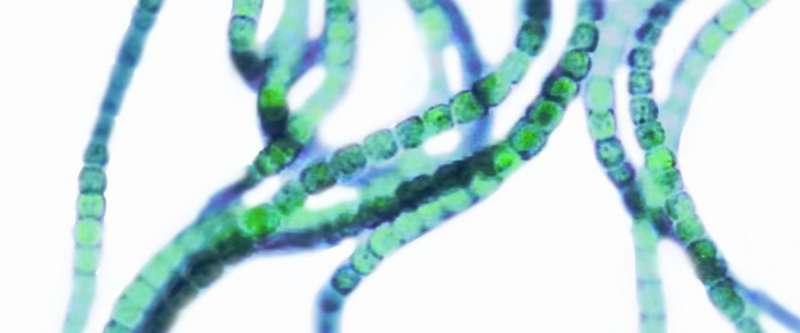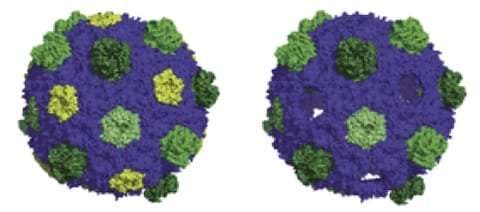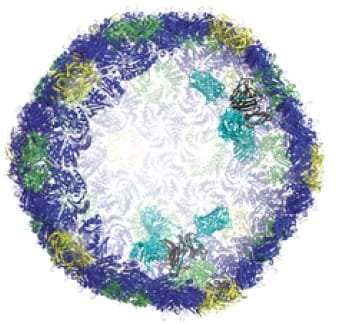Scientists find new methods to control bacterial factories for biotech aims

The lab of Cheryl Kerfeld has announced a breakthrough in manipulating miniature factories, found in bacteria, that hold much promise in the biotech field.
The factories, called expand iconbacterial microcompartments, are widespread in nature and do different things depending on the host. For example, in expand iconcyanobacteria which harvest energy from the sun, they help to construct high energy compounds. In our own guts, pathogenic bacteria use the factories – because the processes they perform are inefficient outside of them and sometimes use toxic materials – to outcompete our "good" bacteria.
Scientists want to retrofit the factories with new machines to perform designed functions. The synthetic versions could sustainably make biofuels, industrial materials, and nanoscale medical devices.
But the factories are very tough to work with.
"Current technologies require many days to prepare and extract a synthetic factory shell," says Andrew Hagen, a post-doc in the Kerfeld lab. "We also have had limited options to insert custom machinery in it. I wanted to develop better ways to do those two things."
In a new Nature Communications publication, the MSU-DOE Plant Research Lab team announces new methods to manipulate factories:
- Complementation-based Affinity Purification (CAP): which quickly screens for the assembly and extraction of the factories
- Encapsulation via Covalent-linkage (EnCo): which helps to predictably insert custom machinery in the factories

CAP: Piecing together factories like soccer balls
The factories look like soccer balls. Their walls are made of expand iconprotein tiles, shaped like hexagons and pentagons, that snap together to form an enclosure.
In the lab, scientists rely on chemical mixtures to make synthetic factories. The challenge has been to efficiently fish those out from the mixtures once they're completed.
The new method shows an easier way to extract the factories:
- The team creates a factory that lacks one type of the wall protein tiles. Imagine a soccer ball without the black pentagon parts;
- They add a tag to the missing tile. The tag works like a microchip that identifies a house pet;
- They add the tile back to the mixture, where it snaps into place when it finds the factories;
- The team extracts the factory with the help of the tagged tile. The team attracts that tag with a system that works like Velcro.
EnCo: molecular super glue
The scientists also report a method to insert custom expand iconenzymes, the machines, inside the factories. It relies on a new technology, called SPY, that works like protein super glue.
"The system has two entities, SpyTag and SpyCatcher, that are attracted to each other," Andrew says. "We insert a SpyCatcher "docking site" on the inside of a factory wall. We then add a SpyTag on the machinery. Once in the same environment, the SPY system comes together like glue."

Once 'glued' to a factory, the machinery can't get out.
So far, the team has managed to insert 60 copies of a single enzyme into a factory. The team aims to increase that number, as one factory could ideally fit around 200 copies.
Andrew adds, "We even put in two different colored proteins. We showed we can program different ratios of each protein, based on the final "hue" of the shell. This is important for factories that will require multiple production steps."
Future Directions
The two new methods work well together. The team has produced a factory shell, inserted machinery, sealed it off, and extracted it in experiments.
Next is to realize some of the technology's promise.
One application is to produce chemicals that are used in industry. Another Kerfeld lab scientist is working on producing the molecule that gets turned into rubber, a process that usually needs fossil fuels. The team is also considering medical applications, like vaccines, and energy materials that are friendly to the environment.
"We think other scientists can use these methods with different bacteria and their factories," Andrew says. "There is a good chance they will adopt them widely."
More information: Andrew Hagen et al. Programmed loading and rapid purification of engineered bacterial microcompartment shells, Nature Communications (2018). DOI: 10.1038/s41467-018-05162-z
Journal information: Nature Communications
Provided by Michigan State University




















